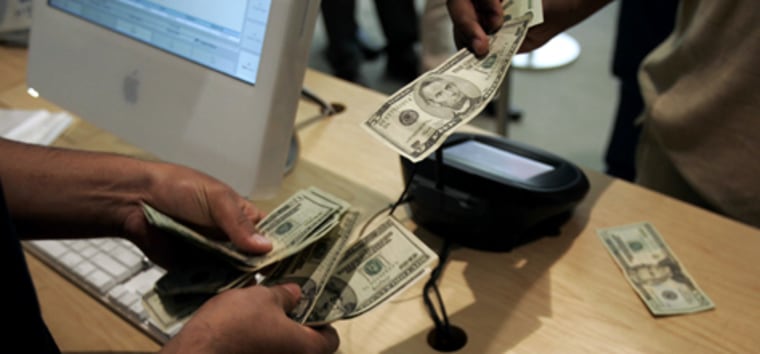Electronic payments – by phone, card and computer – continue to gain market share. And yet, millions of Americans choose to use cash.
Some have no alternative; they don’t have a checking account. Some value the privacy they get with cash transactions or the psychological sense of security knowing that cash is always accepted. For some families, cash is cheaper than using credit and helps them control spending.
But there is a cost to using cash – in both time and money – that’s not always taken into account. Those costs include fees to use a check-cashing service, withdraw from a non-network ATM fee or access wages loaded onto a payroll card.
A new study by Tufts University, The Cost of Cash in the United States, puts that price tag at about $200 billion a year. This figure includes $55 billion in higher costs to businesses, $43 billion for U.S. households and $101 billion in missed tax revenue because of off-the books transactions. For the average American family, the cost of cash is about $1,739 a year. The authors characterize their estimates as conservative.
“Obviously, cash is never going to go away; it’s an important part of the economy,” said study co-author Bhaskar Chakravorti, executive director of the Institute for Business in a Global Context at Tufts. “But we need to recognize the costs it’s imposing – both real costs and opportunity costs.”
The report, based on a survey of 1,000 Americans, found that:
The cost of cash is higher for poorer and unbanked Americans
Someone without a bank account pays an average of $3.66 more a month than someone with a bank account.
“Those who are unbanked are four times more likely to pay fees to access their own money. That’s a significant difference,” Chakravorti said. “A lot of people have the idea that cash is a poor man’s best friend. We feel that the poor are actually getting screwed across the board. They’re definitely being hurt dealing with cash.”

The cost of using cash does not happen at the point of sale.
The added expense comes from the time and money it takes to get that cash. The average American spends 28 minutes each month (5.6 hours a year) going to the bank or ATM to fetch cash. And this doesn’t count the time spent waiting in line. The average fee to use a non-network ATM is now about $3.85 per transaction.
Other significant findings: African Americans are more than twice as likely as other racial groups to pay for access to cash. Retirees are less likely to pay, probably because they often like to go to the bank and use a teller.
A key cost factor is the way people receive their wages. Someone who is paid by payroll card (prepaid debit card) faced average costs more than four times as much as the rest of those in the survey. Those who had direct deposit or who received their pay in cash had the lowest fees.
The study found that getting paid electronically (either through direct deposit or a payroll card) is often significantly cheaper than receiving a paper check if there are fees involved to cash that check for those without a bank account.
Who has the cash?
Most of us have some cash on hand, but that amount varies by income and key demographic factors. Here are some key findings from the study:
- Those in households with income of approximately $20,000 to $100,000 a year said they usually have less than $100 in cash.
- Americans under age 35 have median cash balances roughly half the size of those over 55, but they pay more in fees than older Americans.
- Men carry nearly double the amount of cash that women do. Men are also slightly more likely to always keep some cash on hand than women. This might explain why men use roughly 50 percent more cash each month than women.
- Self-employed and multiple job holders had the greatest cash balances.
- Latinos, Pacific Islanders and Native Americans reported much higher average cash holdings than white, African American, and especially Asian Americans.
Is there a lesson here?
Benjamin Mazzotta, a research fellow at Tufts who co-authored this study, believes it has important public policy implications. That is: Should something be done to help people on fixed incomes or those who don’t have or don’t want a bank account, but who need a modern and cost effective way to spend their money?
“Why shouldn’t they have access to reliable, cheap, universally accepted payment instruments like the ones you and I use and take for granted every day, like debit and credit cards and direct deposit?” he asked.
The National Consumer Law Center (NCLC), an advocacy group for lower-income and other disadvantaged Americans, agrees that it’s important to give people access to the world of electronic payments, so they don’t have to rely on cash. But staff attorney Lauren Saunders isn’t convinced all of the new electronic payment systems are superior to cash, which is so easy to use.
“In the financial world, there are costs to everything,” Saunders said.
NCLC wants people to have access to both cash and electronic payments, whatever works for them.
“We shouldn’t discourage cash and push everybody to electronic payments because a lot of that is being driven by industry looking for ways to get their two cents out of it; to earn fees that you don’t get when people pay with cash,” she said. “Cash is still very useful.”
Herb Weisbaum is The ConsumerMan. Follow him on Facebook and Twitter or visit The ConsumerMan website.